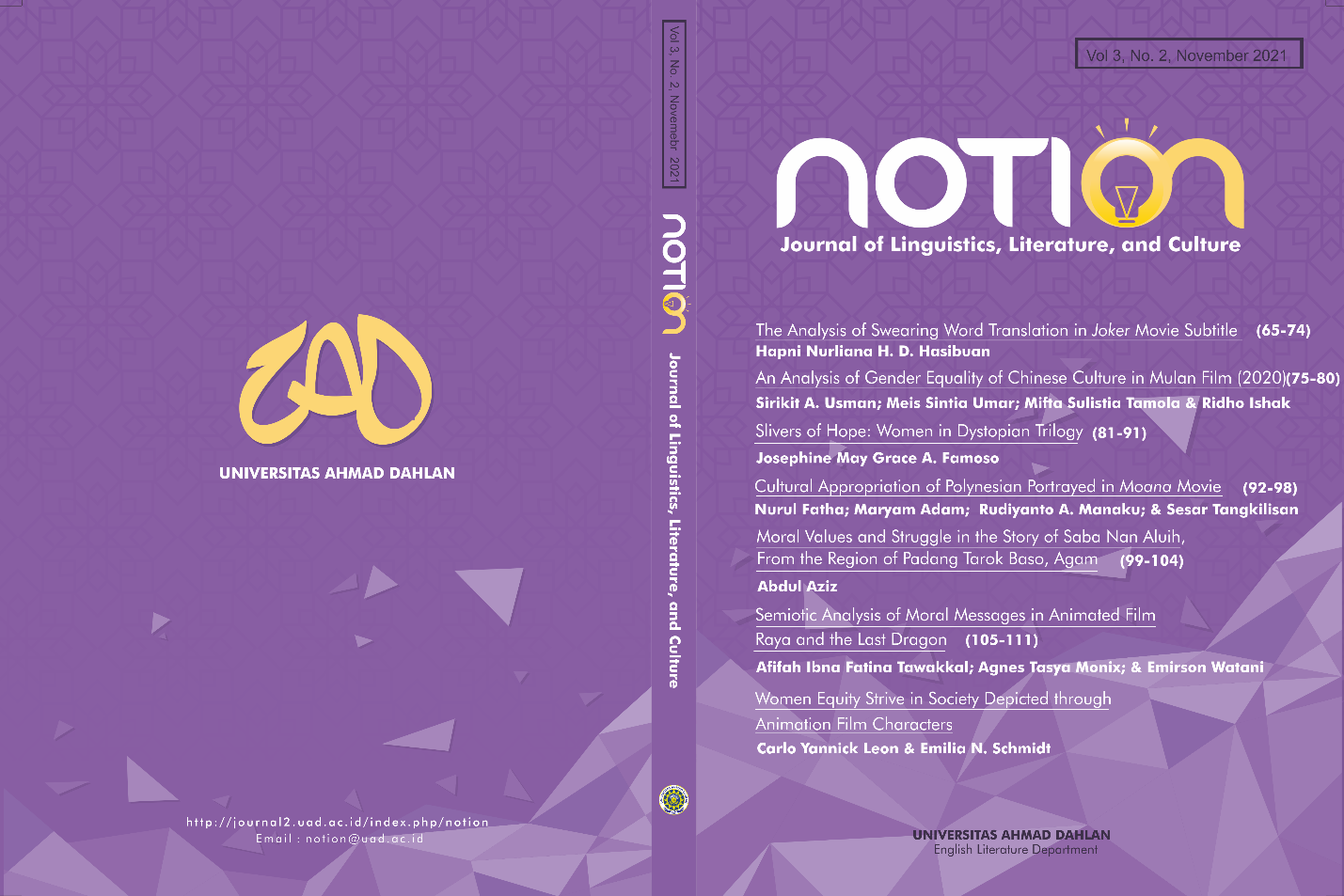Cultural Appropriation of Polynesian Portrayed In Moana Movie
DOI:
https://doi.org/10.12928/notion.v3i2.4885Keywords:
cultural appropriation, Polynesian, cultural exploitation, filmAbstract
This research aims to identify and describe cultural appropriation that were found in Moana. Cultural appropriation is one of the negative actions that can harm one culture. This action generally occurs due to a lack of understanding and appreciation of a culture. Based on Rogers[6] cultural appropriation as the use of a culture's symbols, artifacts, genres, rituals, or technologies by members of another culture, is inescapable when cultures come into contact, including virtual or representational contact. Rogers also divided cultural appropriation into four types, there are cultural exchange, cultural dominance, cultural exploitation, and transculturation. Based on Rogers theory above, cultural appropriation that were found in Moana is cultural exploitation. This research was used Qualitative descriptive method. The source data of this research are from “Moana” by Ron Clements and John Musker. This movie was released in 2016 with 113 minutes duration. This analysis shows there are four points of cultural appropriation that were found in “Moana”. Firstly, depiction figure of “Maui”, a demigod figure illustrated very different from the original form in the movie Moana. Secondly, depiction of Kakamora people. Thirdly, depiction of the cliché coconuts. Fourthly, Disney removing Maui’s family out of the tale. This leads to deviations in views towards the representatives of the population and Polynesian beliefs.
References
Bennett, N., Borg, W. R., & Gall, M. D. (1984). Educational Research: An Introduction. In British Journal of Educational Studies (Vol. 32, Issue 3, p. 274). https://doi.org/10.2307/3121583
Elmusharaf, K. (2018). INTRODUCTION TO Training course in research.
Hesaraki, R. M. (2014). Literature and Culture: Both Interaction and Effectiveness Mohammad. 4(3), 1376–1378.
Nassaji, H. (2015). Qualitative and descriptive research: Data type versus data analysis. Language Teaching Research, 19(2), 129–132. https://doi.org/10.1177/1362168815572747
Rogers, R. A. (2006). From cultural exchange to transculturation: A review and reconceptualization of cultural appropriation. Communication Theory, 16(4), 474–503. https://doi.org/10.1111/j.1468-2885.2006.00277.x
Stall-Meadows, C. (2018). Cultural Appreciation or Cultural Appropriation. Bloomsbury Fashion Business Cases. https://doi.org/10.5040/9781474208765.0014
W. Creswell, J. (2014). Research Design ( vicki knight (ed.); 4th editio). sage publication.
Wellek, R., & Warren, A. (1956). Wellek-Theory of Lit.pdf.
Young, J. O. (2008). Cultural Appropriation and the Arts. Cultural Appropriation and the Arts, 1–168. https://doi.org/10.1002/9780470694190
Downloads
Published
Issue
Section
License
Copyright (c) 2021 Nurul Fatha, Maryam Adam, Rudianto A. Manaku, Sesar Tangkilisan

This work is licensed under a Creative Commons Attribution 4.0 International License.
Authors who publish their articles in NOTION: journal of Linguistics, Literature, and Culture agree to the following terms:
- Authors retain the copyright and grant the journal right of first publication with the work simultaneously licensed under a Creative Commons Attribution 4.0 International License that allows others to share the work with an acknowledgement of the work's authorship and initial publication in this journal.
- Authors are able to enter into separate, additional contractual arrangements for the non-exclusive distribution of the journal's published version of the work (e.g., post it to an institutional repository or publish it in a book), with an acknowledgement of its initial publication in this journal.
- Authors are permitted and encouraged to post their work online (e.g., in institutional repositories or on their website) prior to and during the submission process, as it can lead to productive exchanges, as well as earlier and greater citation of published work.





